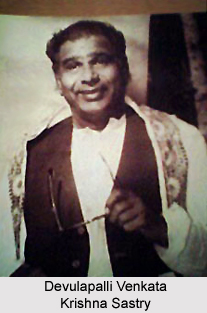 Bhava Kavitvam refers to the poetic movement which started in the 1920`s. The term Bhava Kavitvam was first used to describe the distinctive poetic compositions of Rayaprolu. It is generally agreed that this movement was chiefly inspired by the English lyric. Bhava Kavitvam manifested itself in different forms in different poets. The chief feature of the Bhava Kavitvam is a certain freedom in the choice of the subject and in the mode of expression. However, it is not so much a difference of metrical and prosodic features that distinguishes this poetry from classical Telugu poetry; rather, the emphasis on bhava (emotion) marks it apart from the rasapradhana (sentimental) poetry of the classical style. Some striking features of this poetry are the subjective treatment of experience; greater focus on spiritual beauty than on the merely physical; worship of the metaphysical rather than material nature; celebration of prapatti, or total surrender to the Divine. Bhava Kavitvam takes different forms, such as love poetry, patriotic verse, poetry of social reform, nature poetry, and bhakti, or devotional poetry. Running through all these manifestations is the thread of musicality, the feature that enabled these lyrics to be sung. This seems a major reason for the popularity of the movement.
Bhava Kavitvam refers to the poetic movement which started in the 1920`s. The term Bhava Kavitvam was first used to describe the distinctive poetic compositions of Rayaprolu. It is generally agreed that this movement was chiefly inspired by the English lyric. Bhava Kavitvam manifested itself in different forms in different poets. The chief feature of the Bhava Kavitvam is a certain freedom in the choice of the subject and in the mode of expression. However, it is not so much a difference of metrical and prosodic features that distinguishes this poetry from classical Telugu poetry; rather, the emphasis on bhava (emotion) marks it apart from the rasapradhana (sentimental) poetry of the classical style. Some striking features of this poetry are the subjective treatment of experience; greater focus on spiritual beauty than on the merely physical; worship of the metaphysical rather than material nature; celebration of prapatti, or total surrender to the Divine. Bhava Kavitvam takes different forms, such as love poetry, patriotic verse, poetry of social reform, nature poetry, and bhakti, or devotional poetry. Running through all these manifestations is the thread of musicality, the feature that enabled these lyrics to be sung. This seems a major reason for the popularity of the movement.
The theme of love received a novel treatment in the hands of bhavakavis (sentimental poets). It is not the fulfilment of love, but the eternal waiting of lovers, that is celebrated in these poems. Abburi Ramakrishna Rao`s Mallikamba (1915) and Duvvuri Rami Reddy`s Kadapati Veedkolu (1924) exemplify this trend. Poets often describe an imaginary beloved and elevate her above and beyond the familiar restricting roles to assume newer forms- woman as the symbol of Viswaprema (universal love), as friend, philosopher, and as imaginary yet enticing divinity. Devulapalli Venkata Krishna Sastry`s Urvasi (1926-29), Adivi Bapriraju`s Sasikala (1939), and Tallavajjula Sivasankara Swamy`s Hridayeswari (1926) belong in this category. Some poets celebrate marital love and treat the man-woman relationship as the objective co-relation of atma-paramatma (lower self and higher self) union. Viswanatha Satyanarayana`s Girikumaruni Prema Geethaalu (1953) is a striking instance of this kind.
Since the Bhava Kavitvam developed against the backdrop of the Indian nationalist movement, patriotic verse and poetry of social reform emerged as an important branch of this poetry. Songs of anti-imperial protest urging freedom, written in vers libre, gained immense popularity in the 1930s and 1940s. Chilakamarti Lakshmi Narasimhan`s Bharatha Khandam, Duvvooris`s Naivedyam (1921), and Grimella Satyanarayana`s Ma koddee thella dorathanam are some of the most powerful patriotic verses of this school. Biographical verses written on the lives of heroes from the past and contemporary life mainly form a part of this kind of poetry. Gadiyaram Venkata Sesha Sastri`s Sivabharatham on the life of Shivaji and Jandhyala Papayya Sastry`s many short lyrics on the life of Lord Buddha are good examples of this form. Gandhiji was the subject of countless Telugu poems written during this period; Devulapalli`s Gandhiyugam, Tummala Sitarama Murthy`s Bapuji Atmakatha (1951), and Basavaraju Appa Rao`s lyrics on Mahatma Gandhi merit special mention.
Bhava Kavitvam urged social change and reform. Gurram Jashuva`s Gabbilam (1941) is a powerful critique of caste and class structure in Indian society; Tripuraneni Ramaswamy Chaudhuri`s Suthapuranam (1954) makes a strong plea for the abolition of caste distinctions; Katuri Venkateswara Rao`s Gudigantalu demands that temple doors be thrown open to untouchables. Poetry thus became a social act.
Nature poetry evoking and celebrating the landscape of the Telugu land constitutes yet another important strand of Bhava Kavitvam. Devulapalli seeks total identification with nature in his Krishna Paksham (1925); Jandhyala empathizes with floral maidens in Pushpa Vilapam; Abburi shows how nature spurs love in Oohaganam (1918). Viswanatha`s Kinnerasani Patalu (1924) and Nanduri Subba Rao`s Yenki Paatalu (1925) are examples of the beautiful pastorals and moving rural romance that Bhava Kavitvam created. Poets composed lyrics to folk tunes that were popular among different regions of Andhra. Duvvuri captured the rhythms of farmers` lives in Krisivaludu (1919). Nandoori`s Yenki and Naidu bava have become living legends in Telugu literature.
Finally, bhakti kavitvam, or devotional poetry, forms an important tributary in the streams of bhava kavitvam. Poetry became an act of self-surrender, and the poets submitted themselves totally to the will of God. Puttaparthi Narayanacharyulu`s Sivathandavam (1940) is a powerful poetic tribute to Lord Shiva; Devulapalli pays homage to a universal God in Mahathi; Jandhyala invokes the myth of Radha-Krishna to express his devotion to Lord Krishna; Basavaraju`s Gopika Geethalu (1921), too, invokes Lord Krishna through dedication and devotion. These form a part of the philosophy of Krishna tatvam, in which the devotee takes the place of Radha the beloved and views God as Krishna, the "universal lover."
Thus, Bhava Kavitam comprised a number of different themes in its entire body of work.



















